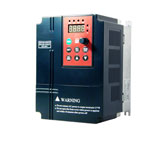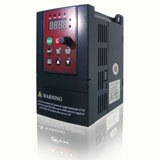Before you select kind of cable for your consumer, you need to calculate expected operating current of cable which depends of rated power of your consumer. After that, before you select kind of cable for your consumer, you need to check size of cable which needs to satisfy next conditions:
When do we use isolated power supply for driving each 6 IGBTs in an inverter? Some applications use bootstrap method which is not isolated. Using 6 isolated power supplies for an inverter with some extra peripherals may increase the overall cost. So, how should we choose which method to use by considering both performance and cost? Generally, which method is used in industrial application such as VFD or UPS from 1hp to 100hp?
The AC drive is as variable frequency drive which allows the motor to be operated over a range of speed in a controlled manner, and since you can control the speed of the motor it could have the effect of a soft starter.
AC drive is obviously more costly, it can have two acceleration sessions with different ramping rates (from still to minimum speed with and from min speed to target speed), some delay is added prior to start.
Incorrect phase sequence is a human error which can be corrected by testing before putting the motor into service. It is not worth to invest on the auto adjustment of the phase sequence. If you really want it, I can suggest to use a VFD and operate it at a fixed speed, selection of phase rotation can be done by a change of one parameter setting and you also can apply physically motor shaft direction sensor to feedback to the VFD.
You're getting a lot of energy savings information which are great benefits of VFDs on centrifugal loads. But strictly from a straight forward cost standpoint, it's the price of the equipment (contact me off line.. I'll give you budgetary pricing) plus how much time you estimate to mount and wire. (Figure it in days. ie one day, two days, etc). The automation and control is a separate issue.
Making your own converter would be a good project. It could be simple without all the control and communication circuits. You will have to deal with motor starting however. You will have to decide on variable voltage or variable frequency, with near constant volts per hz (maybe boost to get starting torque). A cost comparison is hard to make depending on your ingenuity. The intellectual challenge is worth something.
If your supply voltage is 220 VAC single phase and you want to keep the solution simple, you should not use a 3 phase 380 volt motor. Just use a 220 Volt 3 phase motor, which is widely available and cheap. Then you use a standard 220 Volt 3 phase VFD to run the motor. The rectifier on the VFD will take 1 phase or 3 phase, after all it is converted to DC anyway before driving the output IGBT.
We do use vfd to go 1ph to 3 ph all the time; if 230v 1ph avail, a xfmr is used on it 1ph to make it 380 then use a 380v 1ph in to 380v 3ph out vfd FOR MOTORS. No, if you try to use a cheap variable frequency drive to make 3ph and power stuff OTHER than motors, it will not work since the cheap vfd makes no voltage sine wave. There are companies who make 1ph to 3 ph filtered converters but they are a lot more expensive than cheap $ 200 vfd.
VFD manufacturers and Engineers have stated the best way to address these high frequency ground current issues is by providing a high frequency low impedance path which these currents will always follow. This method will not only address the motor bearing current issues, but will also address sensitive device (interference) and arcing/sparking (safety), which brushes cannot.
The original PM machine is used as a direct drive in the oil well. Getting a gearbox in between really is not feasible. That is the reason I try to see if a high pole count induction motor can do the job. When the motor is installed in a new well, we will start it running at 30 to 50 RPM for a few weeks, than increase the RPM gradually to 300 to 450 RPM over the next year or so.
In PV inverters there is a good reason to have the maximum inverter efficiency. Instead, in the combination VFD (inverter + motor) it is not interesting to know exactly the inverter efficiency. In certain conditions it is possible that inverter efficiency is lower but motor efficiency is better. The same VFD in another working point could have a better inverter efficiency but a bad motor efficiency. Therefore, selecting a VFD, I will look to total efficiency and never to the inverter efficiency alone.
In my opinion the most important consideration is the application itself. Variable frequency drives are current limited devices and choosing the right VFD requires that the VFD be able to deliver the needed current for all circumstances.
As starting torque is important for its selection we must give details of torque required based on drive (may be gear, load). Also important is location of variable speed drive. If it is away from motor then we have to provide chokes for impedance. This is generally told by supplier. We also need to inform the bypass system for VFD if our application is important from application point of view.
Category
AC Motor Control
Featured
 This low voltage (single phase 220V, three phase 380V) variable frequency drive manufactured by Gozuk has compact design and integrated advanced technology ...
This low voltage (single phase 220V, three phase 380V) variable frequency drive manufactured by Gozuk has compact design and integrated advanced technology ...
 Special magnetic flux vector control VFDs
Power range: single phase 1.5kW to 2.2kW, 3 phase 0.75kW to 400kW
Integrated RS485, Modbus-RTU communication protocol
32 ...
Active Front End (AFE) variable frequency drive has some harmonic filtering at the input to the VFD that is "programmable" on the fly. Basically, a microprocessor ...
An inverter duty motor can deal with the higher voltage spikes produced by VFDs also can run at very slow speeds without overheating. The general purpose motor ...
Multiple motors operation is quite common application. There are many applications like textile, printing etc where multi motor operation is very common. I ...
In summary, when using a VFD there are many benefits and cost saving possibilities for pumping applications in the irrigation sector. It is important to look ...
Special magnetic flux vector control VFDs
Power range: single phase 1.5kW to 2.2kW, 3 phase 0.75kW to 400kW
Integrated RS485, Modbus-RTU communication protocol
32 ...
Active Front End (AFE) variable frequency drive has some harmonic filtering at the input to the VFD that is "programmable" on the fly. Basically, a microprocessor ...
An inverter duty motor can deal with the higher voltage spikes produced by VFDs also can run at very slow speeds without overheating. The general purpose motor ...
Multiple motors operation is quite common application. There are many applications like textile, printing etc where multi motor operation is very common. I ...
In summary, when using a VFD there are many benefits and cost saving possibilities for pumping applications in the irrigation sector. It is important to look ...
Recent
Increase the speed of a motor by VFD
VFD in Crane and Hoist Applications
VFD for Fire Pump Motors
Is it VFD the best solution to control pump?
3HP VFD, single phase to three phase VFD
Insulated bearings for electric machines
Control ABB VFD through RTD 250ohm directly on water temp
Variable frequency drive Preventive Maintenance
Large VFD trips with power supply by transformer
Induction motor power factor
Understanding VFD basics
Does the motor lifetime depend on the starts number & frequency?
VFD in Crane and Hoist Applications
VFD for Fire Pump Motors
Is it VFD the best solution to control pump?
3HP VFD, single phase to three phase VFD
Insulated bearings for electric machines
Control ABB VFD through RTD 250ohm directly on water temp
Variable frequency drive Preventive Maintenance
Large VFD trips with power supply by transformer
Induction motor power factor
Understanding VFD basics
Does the motor lifetime depend on the starts number & frequency?

